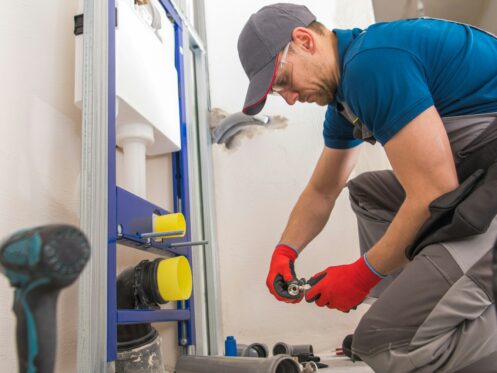Moving into a new home is an exciting milestone, but it comes with its own set of responsibilities. One important aspect that often goes overlooked is the home’s plumbing system. While it might not be the first thing you think about, understanding and maintaining your plumbing is crucial for preventing costly repairs and ensuring your home runs smoothly.
As a new homeowner, you should familiarize yourself with the basics of your plumbing system. Knowing where the main water shutoff valve is located can save you from disaster if you ever have a major leak. Identifying the various pipes and fixtures throughout your home will help you detect issues early. Awareness of how water pressure and flow affect your plumbing can also guide proper maintenance practices.
Preventative care is your best defense against plumbing issues. Conducting regular checks for leaks and corrosion, sticking to a maintenance schedule, and handling minor repairs yourself can keep small problems from turning into big headaches. With a bit of knowledge and proactive care, you can avoid many common plumbing pitfalls and enjoy peace of mind in your new home.
Understanding Your Plumbing System
As a new homeowner, the first step in mastering your plumbing system is locating the main water shutoff valve. This valve controls the water flow into your entire house and is critical in case of a major leak or other emergency. Typically, you can find it in the basement, near the water heater, or outside the home close to the street. Knowing the exact location can save you precious time and minimize water damage in a crisis.
Next, take the time to identify and map out the water pipes and fixtures throughout your home. This means understanding which pipes go to which parts of the house, where your sinks, tubs, and appliances are connected, and knowing the location of shutoff valves for individual fixtures. Mapping these out helps you diagnose problems quickly, should they arise, and gives you a clear picture of how water travels through your home.
Understanding water pressure and flow is also essential. Water pressure relates to how forcefully water moves through your pipes. If the pressure is too high, it can strain your pipes and fixtures, leading to leaks. If it’s too low, it can indicate a blockage or problem in the main line. Use a pressure gauge to check the water pressure in your home, and adjust the pressure regulator if necessary. Maintaining proper water pressure ensures your fixtures work efficiently and prolongs the lifespan of your plumbing system.
Preventative Maintenance
Preventative maintenance is your best ally in maintaining a trouble-free plumbing system. Regularly checking for leaks and corrosion is a simple yet effective way to prevent larger issues. Examine exposed pipes under sinks and around appliances like water heaters for any signs of moisture, rust, or white deposits, which could indicate a leak or corrosion. Early detection allows you to fix small problems before they escalate.
Creating a maintenance schedule for flushing your water heater is another vital task. Over time, sediment can build up inside the tank, reducing efficiency and leading to potential damage. Flushing the water heater at least once a year helps remove this sediment, ensuring it runs smoothly and extends the appliance’s lifespan.
Snaking your drains regularly can prevent clogs and buildups that cause slow drainage or backups. Hair, soap scum, and food particles are common culprits for clogged drains. Using a drain snake or similar tool every few months can keep your drains clear and functioning correctly. Additionally, consider using drain covers to catch larger debris before it enters your plumbing system.
Maintaining your plumbing system with these straightforward steps can save you from unexpected and costly repairs. Regular checks and simple upkeep go a long way in ensuring your home’s plumbing remains in top condition.
Common Plumbing Issues and DIY Fixes
As a new homeowner, you’ll likely encounter common plumbing issues that you can fix yourself. Knowing how to unclog sinks and toilets is an essential skill. For sinks, try using a plunger or a drain snake to remove any blockages. Plunging can often dislodge minor clogs, while a drain snake can reach deeper obstructions. For toilets, a plunger is usually effective, but for more stubborn clogs, a toilet auger might be needed.
Fixing dripping faucets is another common task. A dripping faucet not only wastes water but can also increase your utility bills. Most drips are caused by worn-out washers, O-rings, or cartridges. Start by turning off the water supply to the faucet, then disassemble it to identify the faulty part. Replace the part and reassemble the faucet. Usually, a simple replacement can stop the drip and save you money in the long run.
Handling minor leaks and pipe insulation is also useful. Small leaks typically occur around joints and can often be fixed with plumbing tape or epoxy putty. When it comes to insulating pipes, especially those in colder areas, foam pipe insulation can prevent pipes from freezing and bursting. Measure the pipes, cut the insulation to size, and secure it around the pipes using adhesive or tape. These minor fixes can help you avoid significant plumbing issues in the future.
When to Call a Professional
While it’s great to handle minor plumbing issues on your own, knowing when to call a professional is equally important. Recognizing signs of major issues can save you from extensive damage. If you notice persistent leaks, slow drains despite your efforts, unusual noises in your pipes, or discolored water, it’s time to call a plumber. These signs often indicate underlying problems that require expert attention.
Some plumbing tasks are best left to professionals. Jobs like major pipe repairs, sewer line issues, and water heater installations can be complex and risky. Attempting these tasks without the proper experience can lead to further damage or safety hazards. Plumbers have the skills and tools necessary to handle these jobs efficiently and safely.
Preparing your home for professional plumbing visits can make the process smoother. Clear the area around the plumbing issue to ensure the plumber has easy access. If you know the location of your main water shutoff valve and other key parts of your plumbing system, share this information with the plumber. Being prepared helps the professional diagnose and fix the problem faster, saving you time and reducing inconvenience.
Conclusion
Taking care of your home’s plumbing system involves a mix of understanding, preventative maintenance, DIY fixes, and knowing when to call in the pros. By familiarizing yourself with the basics and staying proactive with maintenance, you can prevent many common issues and address minor problems before they escalate.
When you need expert plumbing services, having a reliable plumber makes all the difference. Legacy Plumbing Experts are here to provide top-notch service for all your plumbing needs. Whether you’re dealing with a minor fix or a major plumbing emergency, we have the skills and experience to keep your home running smoothly.
Contact Legacy Plumbing Experts today to ensure your plumbing system gets the professional care it deserves.

